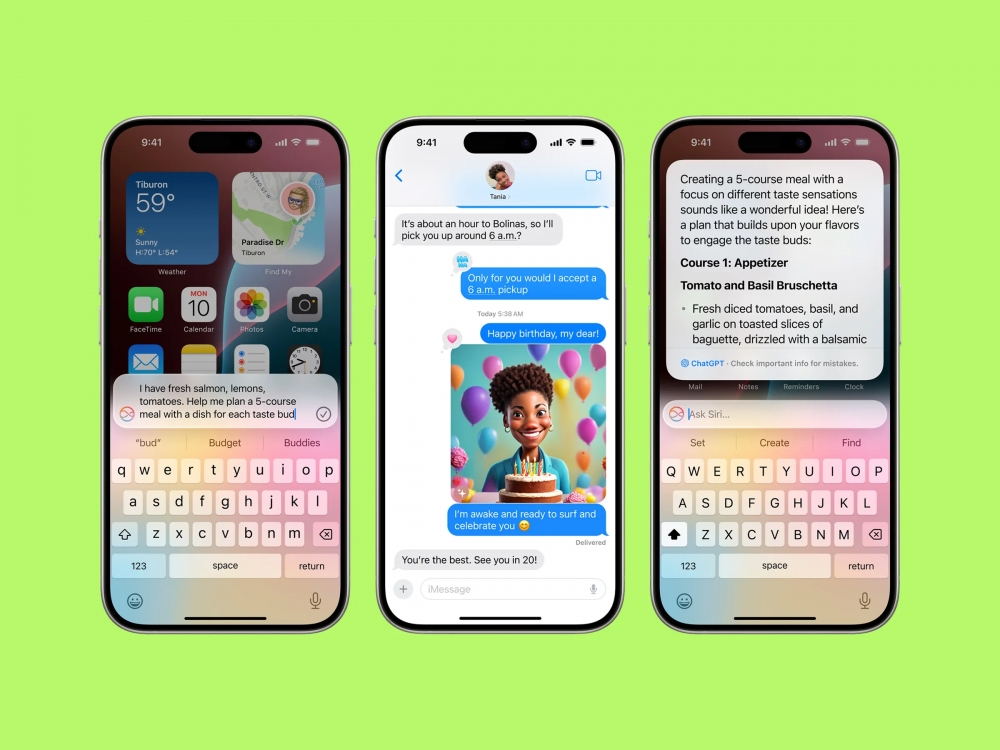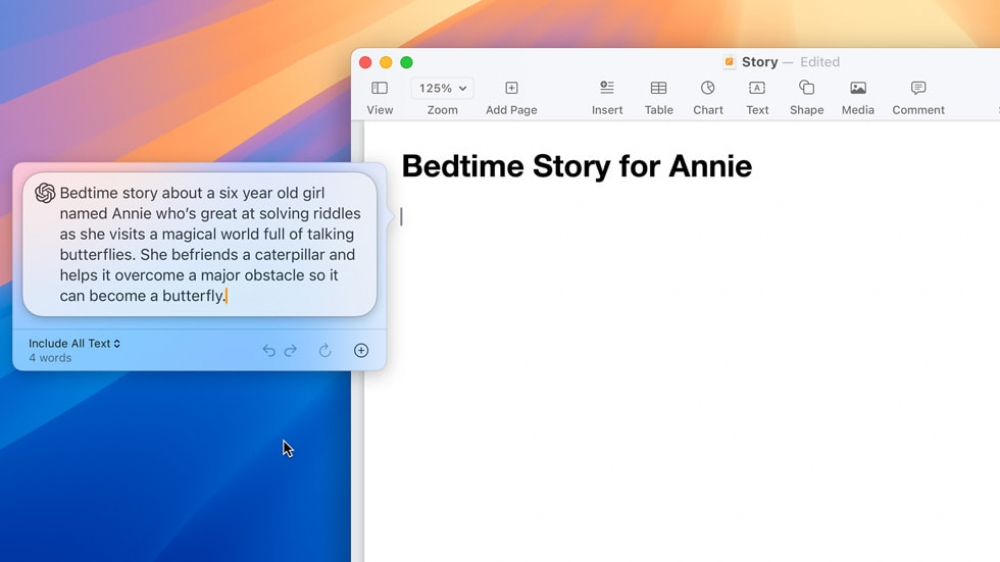Let's Talk About Apple Intelligence: The Future of AI in Your Pocket
- Get ready for the game-changer: Apple Intelligence is coming this fall.
- Your iPhone and iPad just got smarter: Discover mind-blowing AI features.
- Privacy and power: How Apple’s AI respects your data while boosting performance.
- Siri's glow-up: What OpenAI’s ChatGPT brings to Apple’s assistant.
- Beyond the buzz: Why Apple’s approach to AI stands out from the crowd.
What is Apple Intelligence?
Apple Intelligence is Apple’s bold new foray into artificial intelligence (AI), a venture that promises to reshape our daily interactions with technology. This advanced AI ecosystem is designed to be seamlessly integrated into Apple’s hardware and software, creating a more intuitive, efficient, and enjoyable user experience. By leveraging state-of-the-art machine learning and AI capabilities, Apple Intelligence aims to enhance everything from personal productivity to creative endeavors, making its technology smarter and more responsive.
 Image credit: WIRED
Image credit: WIRED
The Promise of Apple Intelligence
At the core of Apple Intelligence is the vision of making AI an integral part of the Apple ecosystem. This includes improvements in Siri’s conversational abilities, automated proofreading and text summarization across various apps, and rapid image generation, among other features. The goal is to make these tools so ingrained in the user experience that they feel like a natural extension of the device itself, rather than an added feature.
Release Date and Compatibility
Apple Intelligence is set to officially launch this fall, coinciding with the release of iOS 18, iPadOS 18, and macOS Sequoia. These operating systems are currently in the developer beta stage, with public betas and official releases expected later this year. However, Apple has specified that the AI features will initially be available only on the iPhone 15 Pro and 15 Pro Max, as well as iPads and Macs equipped with M1 or newer chips. This limitation is due to the high computational demands of the AI processes, which rely on the advanced neural engines, GPUs, and CPUs found in these newer devices.
Why the Hardware Cutoff?
The decision to limit Apple Intelligence to newer hardware stems from the intensive nature of the AI processes. These features require the sophisticated neural engines and processing power available only in the latest chips. Older hardware simply lacks the capability to handle these demanding tasks efficiently. Apple has emphasized that the user experience would suffer on older devices, which cannot provide the necessary computational power for seamless AI integration.
Key Features of Apple Intelligence
 Image credit: Apple Inc.
Image credit: Apple Inc.
1. Writing Assistance
One of the standout features of Apple Intelligence is its suite of writing tools. Integrated into iOS 18, iPadOS 18, and macOS Sequoia, these tools can proofread text, rewrite sections, and summarize content across Apple's ecosystem, including Mail, Notes, and Pages. Third-party developers can also leverage these capabilities through API calls, allowing for a broader application of these advanced features.
In the Mail app, for instance, Apple Intelligence will offer concise summaries of email contents and suggest Smart Replies that address all questions posed in the original messages. Additionally, Priority Messages will bring the most urgent emails to the top of the inbox, ensuring that users never miss important communications.
The Notes app will also benefit significantly from Apple Intelligence. New audio transcription and summarization features will streamline note-taking, while the integrated Math Notes calculator will solve equations typed directly into the body of a note, generating interactive graphs with a single tap.
 Image credit: Apple Inc.
Image credit: Apple Inc.
2. Image Creation and Editing
The new Image Playground app will handle the bulk of Apple Intelligence’s image-related functions. Users will be able to generate images in seconds, choosing from three artistic styles: Animation, Illustration, and Sketch. This standalone app will also integrate with other Apple apps like Messages, allowing users to create and share custom images effortlessly.
In the Photos app, the existing Memories function, which curates significant images into thematic collections, will be enhanced with Apple Intelligence. The AI will select photos and videos based on user prompts, generate storylines, and assemble them into short films. Additionally, new tools like Clean Up, similar to Google’s Magic Eraser, and improved Search functions will be available to Photos users once Apple Intelligence exits the public beta phase.
 Image credit: CNET
Image credit: CNET
3. Enhancements to Siri
Siri, Apple’s digital assistant, will receive a substantial upgrade with Apple Intelligence. The assistant will benefit from improved natural language processing and more conversational speech. Siri's memory will also become more persistent, allowing it to recall details from previous interactions and provide more contextually relevant responses.
Users will be able to switch seamlessly between spoken and written prompts, making Siri more versatile and user-friendly. These enhancements are expected to make Siri a more integral part of the Apple user experience, providing more accurate and helpful assistance.
4. Privacy and Security
Privacy has always been a cornerstone of Apple’s philosophy, and Apple Intelligence is no exception. To prevent data leaks and ensure user privacy, Apple has developed its own private and secure AI compute cloud, known as Private Cloud Compute (PCC). This cloud will handle complex user queries, while most routine operations will be processed on-device using the latest A17 and M-family processors.
Craig Federighi, Apple’s senior vice president of Software Engineering, emphasized that Apple Intelligence is designed to be aware of personal data without collecting it. When a request is made, the AI determines whether it can be processed on-device or needs to utilize the PCC. Only the relevant data for the task is sent to Apple’s servers, minimizing the risk of data interception during transit.
Federighi assured that user data is never stored or made accessible to Apple. It is used solely to fulfill the user’s request, and the code running on Apple’s servers is open to independent inspection to verify this privacy promise.
 Image credit: The Week
Image credit: The Week
Partnership with OpenAI and ChatGPT Integration
In an exciting development, Apple has partnered with OpenAI to integrate ChatGPT functionality into Siri and Writing Tools. This collaboration will enable image and text generation capabilities powered by GPT-4. If Siri’s onboard capabilities are insufficient for a user’s query, ChatGPT will step in, processing the request through OpenAI’s public compute cloud.
To ensure user privacy, the device will prompt for permission before transmitting any requests or attached documents to OpenAI’s servers. This integration aims to provide users with a seamless experience, with Siri delivering answers regardless of where the query is processed.
AI Maximalism vs. Apple’s Approach
Apple’s strategy with generative AI contrasts sharply with the AI maximalist view, which envisions general-purpose chatbots taking over a wide range of complex tasks. Instead, Apple sees generative AI as a commodity technology embedded within broader systems and unbundled into specific features. This approach allows Apple to integrate AI into various aspects of its ecosystem without relying on a single, all-encompassing chatbot.
Apple’s focus on embedding AI into specific features rather than creating a standalone AI product reflects a strategic vision. By integrating AI into the operating system and individual applications, Apple aims to enhance user experiences without the need for extensive cloud-based processing. This approach also leverages the efficiency of Apple’s custom silicon, enabling AI features to run on-device with minimal power consumption.
The Future of AI in Apple’s Ecosystem
While Apple Intelligence represents a significant step forward, it is still a work in progress. The features demonstrated so far are promising, but the real test will come when they are released to the public. Apple’s approach to AI, emphasizing integration and privacy, sets it apart from other tech giants, but it remains to be seen how well this strategy will be received by users and developers alike.
Apple’s commitment to AI integration and privacy could reshape the landscape of consumer technology, setting new standards for how AI is deployed and managed. As the technology continues to evolve, Apple’s unique approach to AI could serve as a model for others to follow, balancing innovation with user trust and security.
So that's all we know so far about Apple Intelligence.
Apple Intelligence is poised to revolutionize the way we interact with technology, offering advanced AI capabilities that enhance productivity, creativity, and user experience. With a focus on privacy and seamless integration, Apple’s approach to AI stands out in a crowded field. As the technology rolls out later this year, users and developers alike will have the opportunity to experience firsthand the transformative potential of Apple Intelligence.
Recommended by the editors:
Thank you for visiting Apple Scoop! As a dedicated independent news organization, we strive to deliver the latest updates and in-depth journalism on everything Apple. Have insights or thoughts to share? Drop a comment below—our team actively engages with and responds to our community. Return to the home page.Published to Apple Scoop on 26th June, 2024.
No password required
A confirmation request will be delivered to the email address you provide. Once confirmed, your comment will be published. It's as simple as two clicks.
Your email address will not be published publicly. Additionally, we will not send you marketing emails unless you opt-in.